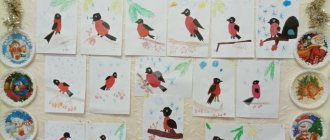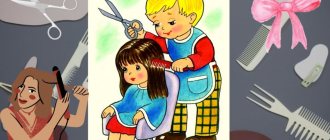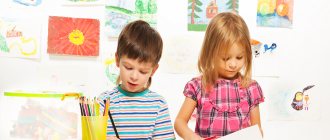Mosquito
That's a good mosquito, He's a daring mosquito. He flew to visit the fly and danced very merrily.
Didactic game “Find a paired picture”
Find a picture exactly like yours.
Dynamic pause “Mosquitoes”
Here are the mosquitoes sitting (Sit on the carpet)
They look in different directions. (Turn left and right, place palm to forehead)
Wanted to frolic (Get on your feet)
They flew off one after another. (Running in circles one after another)
They sang along the mosquito line: “z-z-z.” (Onomatopoeia)
Junior group. Early childhood, nursery. Children 1-4 years old
Summary of the open lesson “Insects” (first junior group) Topic: “ Insects ”
Goal: to form a generalizing concept of
“
insects ” .
Objectives: 1) consolidate knowledge about “
insects ” and teach them to recognize;
teach children to distinguish and name colors (yellow, red, blue, green)
; learn to compare objects by size; practice using...
Lesson notes for the second early age group “Insects” Municipal preschool educational institution “Child Development Center - Kindergarten No. 9”
Notes for the OO “Cognitive Development” “Acquaintance with
insects ” Second early age group Volokolamsk, 2021 Purpose: to introduce children with
insects , demonstrate the diagram...
Butterfly
The butterfly flew in. She flapped her wings beautifully.
Look at the picture and show a butterfly that is different from the others, different from other butterflies.
Construction “Fold a butterfly”
In the picture diagram, children lay out an image of a butterfly from geometric shapes. The teacher asks to show the given figure and name its color.
Drawing "Butterfly"
Children paint one butterfly wing, fold it in half, smooth it with their palm, then open it.
Spider
I'm a spider, not evil at all. I don't eat beautiful flies.
Game with clothespins "Spider"
Use clothespins to make spider legs.
Exercise "Web"
The bug flew and flew and came across a web. Lay out the web mesh in front of you. Place the bug in the middle. Fold the web, unfold it. Move the bug to the web paradise. A bug escapes and flies away - lift the bug up.
Exercise “Dew on the Web”
It rained and droplets remained on the spider's web. Place the drop stones on the web.
Dynamic pause “A spider crawls along a branch”
A spider crawls along a branch, and all the children crawl behind it. (Arms are crossed, the fingers of each hand “run” along the forearm, and then along the forearm of the other hand)
Rain suddenly fell from the sky and washed the Spider to the ground. (Brushes are freely lowered, perform a shaking movement. Then clap on the table, knees)
The sun began to get hot. The spider crawls again. (Palms with spread fingers look to the sides)
And all the kids crawl behind him (Same as in the beginning. “Spiders” crawl up - onto their heads)
To walk along the branch. (Run fingers through hair)
Summary of educational activities for familiarization with the outside world in the 2nd junior group on the topic: Insects
Summary of educational activities for familiarization with the environment in the second junior group.
Topic: “In the world of insects” Author: Novikova I.G., teacher, MAUDO “Kindergarten No. 7”, Yalutorovsk, 2021 Goal: expanding and clarifying knowledge about insects, their diversity and characteristic features. Objectives: • Introduce children to insects: butterfly, ant, bee; • Learn to identify their main features: legs, antennae, wings, head; • Develop the ability to guess riddles by description; • Fix the primary colors. Materials: ant toy, pictures with insects, paper flowers, butterflies, jars of peas and beans, tape recorder, insect sounds, easel, anthill model Lesson
progress
Hello, friend, (offer your hand to the child on the right) Hello, friend!
(offer your hand to the child on the left) Hurry up and join me in a circle! Let's smile and say, "Hello!" To the sun: “Hello!” To all guests: “Hello!” Educator: Children, what time of year is it now? Children: Spring. Educator: What happens in the spring? Children: In spring everything blooms and turns green. Educator: Let's close our eyes and imagine that we are in a green forest clearing. (A melody sounds with the sounds of insects. The teacher lays out paper flowers) Educator: Open our eyes. What did you hear? Children's answers. Educator: Who makes these sounds? Children's answers. Educator: That's right, and you and I ended up in a clearing with little residents. Educator: Guys, what do we see in the clearing? Children: Flowers Teacher: What color are they? Children: Yellow, red, blue, orange, blue, white Educator: Listen carefully to the riddle All four petals of the flower were moving. I wanted to catch him - He took off and flew away. Who is this? Children: Butterfly. (A picture is attached to the easel) Educator: What does a butterfly have? Children: Wings, legs, body, head, antennae. Educator: The butterfly has a long, thin, curved proboscis, which it lowers into the flower and drinks the sweet nectar. The butterfly loves open flowers so that it can sit on them and see what is happening around it. Educator: I suggest playing the game “Butterfly and Flower”. Take one butterfly at a time. (I hand out butterflies) Educator: What color is your butterfly? And you? And yours? Child’s answer Teacher: Listen carefully to the task. Place the butterflies on a flower that is the same color as your butterfly. Children plant butterflies on flowers. Educator: What flower did you plant your butterfly on? And you? Why? Child's answer. Educator: Great, all the butterflies are on their flowers. Let's sit down in the clearing. Educator: Listen to the following riddle It flies tirelessly in the meadows, collects flower nectar. A little time will pass, and delicious honey will be prepared. Educator: Who is this? Children: Bee. (A picture is attached to the easel) Educator: Yes, this is a bee, she flies to collect sweet pollen from the first flowers. So that we can have something delicious later, what? Children: Honey. Educator: What color is it? Children's answers. Educator: Guys, look, the bee is brightly colored. Why do you think? Children: So that no one touches her. Educator: Good guys, the bee seems to be saying: “Don’t come closer! I’ll sting!” Touching a bee is very dangerous; it can sting. What does a bee have? Children: Wings, legs, body, head, antennae. Educator: Guys, look, who is that peeking out from under the flower? Children: Ant Teacher: That's right, let's look at it. What does the ant have? Children: Antennae, head, legs, body Teacher: What color is the ant? Children: Black. Educator: What is the name of his house? Children: Anthill. Educator: At the very beginning of spring, the anthill looks more like a heap of garbage and old pine needles than an anthill (showing a model of an anthill). But as soon as the snow melts, the ants will come out to bask in the sun. After a long winter sleep they were completely exhausted. They don’t even have the strength to shoot back at uninvited guests with caustic formic acid. But a few more days will pass, and the ants will get to work. Formic acid can be dangerous to humans. Therefore, anthills do not need to be disturbed. Educator: Ants love order very much, but during the long winter, beans and peas got mixed up in their anthill. Let's help them. Go to the tables and place the beans and peas in boxes. Game “Sort out the peas and beans” Educator: Check if everything is laid out correctly. Children: Yes Teacher: Take the peas and beans to the anthill. Educator: The ant says thank you. Educator: Now it’s time for us to return home. Sit on the chairs near the easel. Educator: Who did we meet in the forest clearing? Children: Butterfly, ant, bee. Educator: Who remembers what a butterfly drinks? Children's answers. Educator: Why is the bee so brightly colored? Children's answers. Educator: What is the name of the ant's house? Children: Anthill. Educator: How can they be called in one word? Children: Insects. Educator: That's right - these are all insects. What other insects do you know? Children's answers. Educator: They all have three legs on each side. There are six legs in total. And they are all called insects. Well done boys. Now you know that insects can be useful, but they are not always safe.
We recommend watching:
Environmental project in the senior group on the topic: Insects Educational project in kindergarten “Insects” for children in the senior group Summary of educational activities for children of the preparatory group in kindergarten with a presentation. Insects Ecological tale about an Ant for children 5-7 years old
Similar articles:
Lesson summary for the senior group on the topic: Insects and flowers
Poems about insects for preschool children 5-6 years old
Conversation about the caterpillar for children
About beetles for children 5-8 years old
About mosquitoes for children
Progress of the lesson:
The sun woke up early and came to visit us in the morning. He smiled at all the guys and wished everyone well.
Game situation “Birthday Fly”
There will be, there will be children having fun until the morning. Today it's the Birthday Fly Tsokotuha!
Today we are going to visit the Tskotukha Fly. She is the birthday girl today - her birthday is today. And besides us, a variety of guests will come to the fur for the holiday. And here they are.
Next, the teacher shows the picture of “Guest”, names the insect depicted on it and asks to repeat it. After the children complete all the tasks related to this particular “guest,” the teacher asks the children to name him again.
Caterpillar
The caterpillar was crawling. I was surprised by the transformation.
Game with laces “Caterpillar”
Insert the string into the hole, thread it through and wrap it around the track. This is how the caterpillar prepares to become a butterfly.
Musical break "Butterfly"
Children perform movements according to the words of the song: they tear off pieces from a leaf cut out of green paper, lie down on the carpet, run, and wave the crayfish.
Didactic game “The caterpillar became a butterfly”
So the caterpillars became butterflies. Arrange the butterflies on top of the caterpillars correctly: the yellow caterpillar became a yellow butterfly, the red caterpillar became a red butterfly, the blue caterpillar became a blue butterfly, and the green caterpillar became a green butterfly.
Bug
Horned beetles came, solid, rich.
Dynamic pause “The beetle fell” The beetles flew and buzzed: “zh-zh-zh.” (Running with onomatopoeia)
The beetle has fallen and cannot get up. (Lie on your back, swing your arms and legs)
He is waiting for someone to help him. (Adult picks up baby)
Game with buttons "Boots"
Flea beetles came to the fly. They brought her beautiful boots. But the boots are not simple, they have painted fasteners.
Arrange the buttons into circles of appropriate size and color.
Didactic game “Place beetles on flowers”
Tell me what color the beetles are. These beetles love to sit on flowers. But each beetle lands on its own flower - the same color as its own. Place beetles on flowers: red beetles on red flowers, blue beetles on blue flowers, yellow beetles on yellow flowers, green beetles on green flowers.
Application "Ladybug"
Children glue two halves of elytra and a head onto the image of a beetle. Use a black marker to add spots and eyes.




